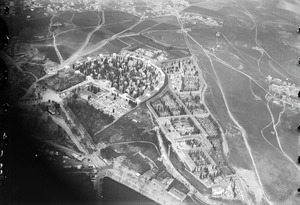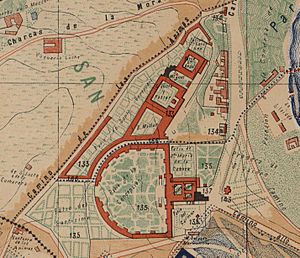Saint Isidore Cemetery facts for kids
Quick facts for kids Saint Isidore Cemetery |
|
|---|---|
|
Cementerio de San Isidro
|
|
 |
|
| Alternative names | Pontifical and Royal Sacramental Arch-confraternity of St Peter, St Andrew, St Isidore and of the Immaculate Conception |
| Etymology | Saint Isidore the Farmer |
| General information | |
| Status | Active cemetery |
| Type | Cemetery |
| Architectural style | Various |
| Address | Calle Ermita del Santo 78 |
| Town or city | Madrid |
| Country | Spain |
| Coordinates | 40°24′03″N 3°43′40″W / 40.40083°N 3.72778°W |
| Construction started | 1811 |
| Inaugurated | 1811 |
| Owner | Archicofradía Sacramental de San Pedro San Andrés y San Isidro |
| Affiliation | Catholic Church |
| Technical details | |
| Floor area | 120,000 m2 (1,300,000 sq ft) |
| Design and construction | |
| Architect | José Llorente |
Saint Isidore Cemetery is a very old and important cemetery in Madrid, the capital city of Spain. It is known for its beautiful and grand mausoleums. The first part of the cemetery was built in 1811. More sections were added later in the 1800s. Many famous Spanish people, like artists, politicians, and poets, are buried here.
Contents
History of Saint Isidore Cemetery
This cemetery is located near the Manzanares River in Madrid. Its full name is very long: "Pontifical and Royal Sacramental Arch-confraternity of St Peter, St Andrew, St Isidore and of the Immaculate Conception." This name tells us about its beginnings.
The cemetery was created by a group of religious organizations called "confraternities." These groups merged in 1587. One of their jobs was to make sure their members had a proper burial. So, they asked to open a cemetery. They chose a spot outside Madrid, close to the hermitage of Saint Isidore.
The first person was buried here in 1811.
A Resting Place for Important People
During the 1800s, Saint Isidore Cemetery became the main burial place for Madrid's wealthy and important families. Many aristocrats, rich business people, politicians, and artists chose to be buried here.
Because of this, the cemetery has seven courtyards filled with amazing mausoleums. These are like small buildings or grand tombs. Architects and artists used their best skills to design them. They added beautiful sculptures, metalwork, and stained glass. Famous architects of that time, like Ricardo Velázquez Bosco and the Marquis of Cubas, designed many of these structures.
The cemetery is still active today. It is considered one of the most interesting cemeteries in Europe. There have been efforts to have it recognized as a "Bien de Interés Cultural" (a site of cultural heritage interest) in Spain.
What Makes Saint Isidore Cemetery Special
The cemetery is in the Carabanchel area of Madrid. It sits on a hill known as the "hill of souls."
Courtyards and Architecture
The cemetery has seven courtyards. The three oldest ones are rectangular. They have a cloister-like design with rows of niches (spaces for coffins). These older courtyards look quite simple.
- The oldest courtyard is called St Peter. It was built in 1811 by architect José Llorente. Here you can find the tombs of important figures like Antonio Fraseri (a doctor to King Ferdinand VII) and the count of Campomanes.
- The St Andrew courtyard was built later, in 1829, also by José Llorente.
- The St Isidro courtyard was added in 1842 by José Alejandro Álvarez.
In the middle of the 1800s, more space was needed. So, the "Patio de la Concepción" (Conception courtyard) was built. This courtyard was designed by Francisco Enríquez y Ferrer. It features columns and towers in a style similar to ancient Roman buildings. This area has many grand mausoleums built in different styles from the 19th century. These grand tombs continued to be built throughout the 1900s, especially during the time known as the Spanish Restoration.
Famous People Buried Here
Many important and well-known people are buried at Saint Isidore Cemetery. Here are some of them:
- Leandro Fernández de Moratín (1760-1828), a Spanish writer and poet.
- Marquess of San Isidro (1806-1885), a Spanish noble, politician, and army officer.
- Conde de Campomanes (1723-1802), a Spanish politician.
- Ángel de Saavedra y Ramírez de Baquedano, Duque de Rivas (1791-1865), a Spanish poet, writer, and politician.
- Diego de León (1807-1841), Count Belascoaín, a military leader.
- Manuel Montes de Oca (1804-1841), a Spanish naval commander and politician.
- Francisco Javier de Istúriz (1790-1871), a Spanish President.
- Ramón de Mesonero Romanos (1803-1882), a Spanish author.
- Frances Mary ("Fanny") Keats (1803-1889), the younger sister of the famous poet John Keats.
- José de Salamanca y Mayol (1811-1883), a Spanish politician and financier, also known as the Marquis of Salamanca.
- Emilio Castelar (1832-1899), a Spanish politician, historian, journalist, and writer. He was President during the First Spanish Republic.
- Francisco Silvela (1843-1905), a Spanish politician.
- Segismundo Moret (1833-1913), a Spanish politician and writer.
- Fernando Primo de Rivera y Orbaneja (1879-1921), a Spanish politician and soldier.
- Consuelo Vello Cano «La Fornarina» (1885-1915), a Spanish singer.
- José Echegaray (1832-1916), a Spanish politician, playwright, and mathematician.
- Antonio Maura (1853-1925), a Spanish politician and prime minister.
- Miguel Primo de Rivera (1870-1930), a Spanish military officer and Prime Minister of Spain from 1923 to 1930. His remains were later moved.
- Felipe de Lazcano y Morales de Setién (1868-1951), a lawyer, businessman, politician, and financier.
- Ante Pavelić (1889-1959), a Croatian leader.
- Fulgencio Batista (1901-1973), a Cuban soldier and politician.
- Miguel Boyer (1939-2014), a Spanish economist and former minister.
- Kardam, Prince of Turnovo (1962-2015), a Bulgarian prince.
- Concha Piquer (1908-1990), a famous Spanish singer.
- Infanta Pilar, Duchess of Badajoz (1936-2020), a Spanish royal.
- José Antonio Primo de Rivera (1903-1936, reinterred 2023), founder of Falange Española de las JONS. His remains were moved in April 2023.
See also
 In Spanish: Cementerio de San Isidro para niños Cementerio de San Isidro, Madrid (Spanish Wikipedia article)
In Spanish: Cementerio de San Isidro para niños Cementerio de San Isidro, Madrid (Spanish Wikipedia article)



